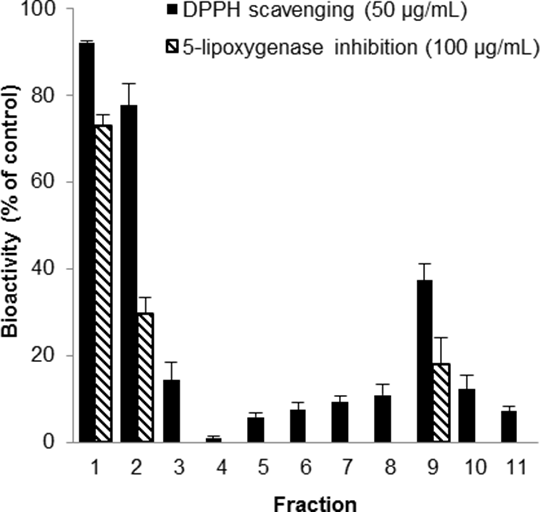Bioactivity-guided fractionation of Australian native stingless bee (Tetragonula carbonaria) propolis extracts, based on in vitro free radical-scavenging and 5-lipoxygenase activities Propolis, a resinous, plant-derived product of honeybees, has been shown to exhibit anti-oxidant and anti-inflammatory properties (1). We recently found that a methanolic extract of propolis collected from Australian native stingless bees (Tetragonula carbonaria) dose-dependently scavenged the stable free radical, 2,2-diphenyl-1-picrylhydrazyl (DPPH; EC50=27.0±2.3 μg/mL), and inhibited the pro-inflammatory enzyme, 5-lipoxygenase (IC50=67.1±9.6 μg/mL) in vitro. However, the active constituents of T. carbonaria propolis are yet to be elucidated. Through bioactivity-guided fractionation, we aimed to identify fractions within T. carbonaria propolis extracts that scavenge DPPH and inhibit 5-lipoxygenase activity in vitro. Propolis collected from 40 T. carbonaria hives in South-East Queensland, Australia, was homogenised and extracted in 2:1 methanol:hexane. The crude methanolic extract was further separated into three sub-extracts of increasing polarity. Two hexane sub-extracts and one methanol-water sub-extract were obtained, evaporated to dryness and reconstituted in dimethyl sulfoxide. Sub-extracts (1-5000 μg/mL) were tested for free radical-scavenging activity using 100 μM DPPH in a colorimetric assay (518 nm; 30 min), and for inhibition of 5-lipoxygenase activity using colorimetry (2). The methanol-water sub-extract was also fractionated using preparative reversed-phase HPLC, and 11 fractions were collected, dried and re-tested for bioactivity using the assays described above. Data are expressed as mean±SEM; extracts and fractions were compared using one-way ANOVA. The polar, methanol-water sub-extract of T. carbonaria propolis was a more potent scavenger of DPPH (EC50=31.1±1.6 μg/mL) and inhibitor of 5-lipoxygenase activity (IC50=42.8±4.6 μg/mL) than the two hexane sub-extracts (n=3; p<0.05). Preparative fractions 1, 2 and 9 from the methanol-water sub-extract had greater DPPH-scavenging activity at 50 μg/mL than the other eight fractions (n=3; p<0.05) (Fig.1). Fraction 1 also showed the greatest inhibition of 5-lipoxygenase activity at 100 μg/mL (n=5; p<0.05) (Fig.1). Solvent controls were without effect in all assays. 
Fig. 1 DPPH (n=3) and 5-lipoxygenase (n=5) activities of T. carbonaria propolis fractions (*p<0.05). Polar constituents of T. carbonaria propolis were responsible for its free radical-scavenging properties and inhibition of 5-lipoxygenase activity in vitro. Repeated fractionation and chemical analysis of fractions 1, 2 and 9 are currently underway to isolate and identify bioactive propolis constituents. (1) Toreti VC et al, Evid Based Complement Alternat Med 2013:697390, 2013 (2) Anthon GE & Barrett DM, J Agric Food Chem 49:32, 2001
|


